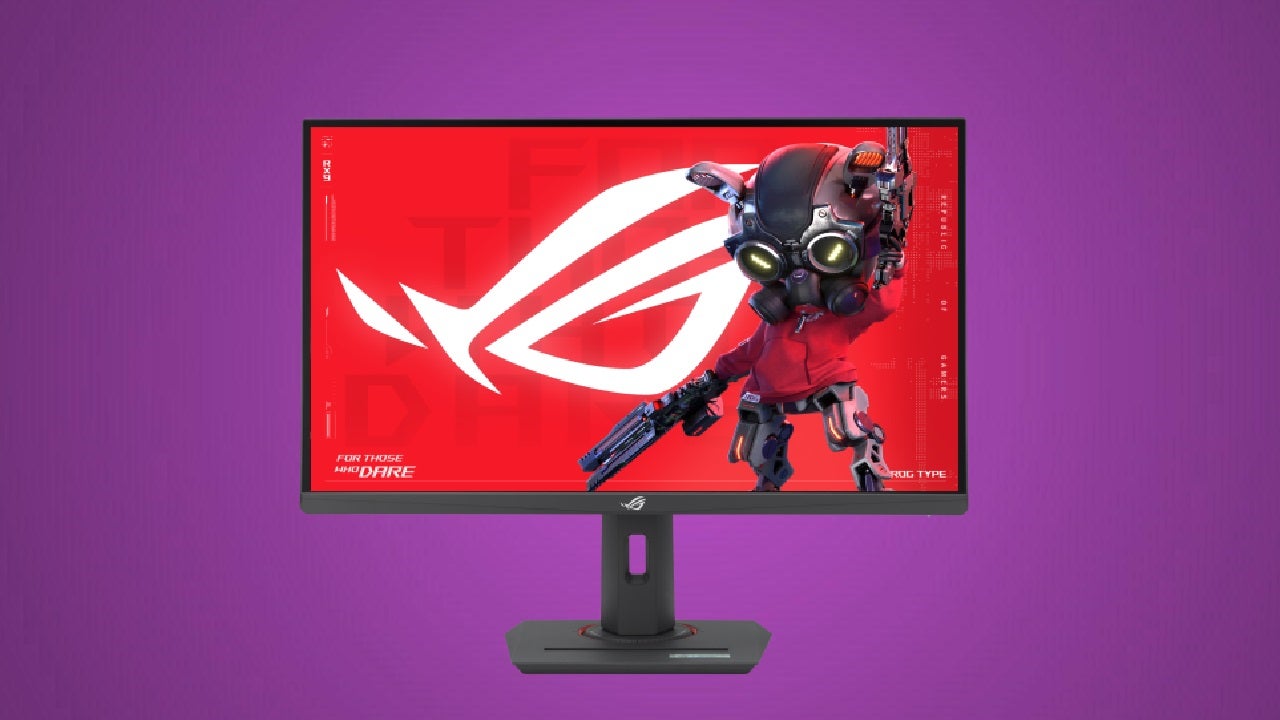4K ultra HD, high refresh rate gaming monitors are finally arriving at reasonable prices, and like the best gaming monitors, the Asus ROG Strix XG27UCS makes a strong case for itself. It’s fast, bright, and excels at fast motion and clarity for gaming and movies. It’s a good monitor that’s not likely to disappoint anyone at only $500, but it also tends to blend in with its competition with middling contrast and few unique features.

Asus ROG Strix XG27UCS – Design and Features
The Asus ROG Strix XG27UCS is a 27-inch gaming monitor with a 4K resolution and 160Hz refresh rate. It’s a follow up to last year’s release, the XG27ADQ, which was the same size but topped out at 1440p resolution. That monitor was widely lauded for offering great picture quality at a very reasonable price, so it’s not a surprise to see a 4K version soon after.
Even though it’s a budget-oriented display — which is strange to say about a $500 monitor — there are only a handful of omissions with its design compared to the likes of the flagship PG32UCDM. There’s no RGB, though its back has plenty of decoration that you’ll still rarely see. It also lacks a USB hub, which is a more meaningful loss but hardly a dealbreaker.

It comes with plenty of flare and the classic Republic of Gamers attention to detail. The back has the same eye imprint as other recent high-end ROG monitors, sans RGB, as well as cybernetic etching on the opposite side. It mixes matte with glossy finishes and genuinely looks very cool.
The stand is identical to the XG27AQDMG I reviewed recently but attaches with a larger circular plate. It offers 4.7 inches of height adjustment, as well as tilt and pivot angles. The monitor can also be rotated to use in portrait orientation, lending itself to being a secondary display for things like Twitch chat or extra productivity. The bottom uses a heavy base instead of feet, which I prefer for centering my Elgato Stream Deck on, that includes a tray to fit a smartphone and a dial to mark precisely where the monitor is pivoted. There’s also a cutout for routing cords to help with cable management and a ¼-20 threaded insert on the top for mounting a webcam, a ring light, or other accessories.

Connectivity is sparse. There’s a single HDMI 2.1 and DisplayPort 1.4 input, as well as USB Type-C for video and power delivery up to 15 watts. There’s also a headphone jack that makes up for its lack of speakers. Interestingly, this version of the XG27 features an internal power supply while the XG27AQDMG comes with an external power brick.

The display itself uses an IPS panel, which is a strength for vivid, accurate colors and wide viewing angles compared to VA, the other leading type of panel used in modern gaming monitors. It’s also much cheaper than OLED monitors, though suffers worse contrast than either with a 1,000:1 ratio. It’s rated for up to 450-nits of peak brightness and supports 10-bit color with rated coverage of 130% of sRGB and 95% of DCI-P3 color spaces. Nvidia G-Sync is supported and works flawlessly. The bezels are very thin, in keeping with the majority of other gaming monitors these days, and do a good job of making its 27-inch area feel expansive.
The monitor technically supports HDR and is VESA DisplayHDR 400 certified but can’t actually deliver a HDR viewing experience. Like many other monitors around this price, its certification is a marketing point that means that the display is compatible with HDR signals and offers 10-bit color. Its peak brightness isn’t high enough to deliver true high dynamic range; it would need to be significantly higher at around 1,000 nits, or sport a contrast far lower, to meet the basic standards for what most would consider “high dynamic range.”

The controls are all located on the right side on the back of the display. There’s a joystick on the top for raising and navigating the OSD as well as four buttons beneath. Two of these buttons are shortcut keys OSD functions that can be set in the software. The other two are pre-assigned to power and showing a quick menu on the right to remind you of your keymaps.
Within, you’ll find a suite of gaming presets and features, though it’s not quite as extensive as Asus’s more expensive ROG Strix and ROG Swift gaming monitors. It does feature Extreme Low Motion Blur (ELMB), which is a returning fan favorite feature. ELMB is Asus’s take on backlight strobing to remove blur from fast motion. This dramatically reduces brightness as it rapidly strobes the backlight but adds clarity to quick in-game camera turns which helps with flick shots in FPS games, for example
Asus ROG Strix XG27UCS – OSD and Gaming Features
The XG27UCS features a similar suite of features as most of Asus’s recent gaming monitors, including extensive picture controls and presets for different genres, gaming features, alternate color spaces for creative work, and more. These options are available through the OSD or through its downloadable software, the Asus DisplayWidget center, though a couple of gaming features require the built-in menu to turn on.
The OSD is split between different tabs for its various features and, if you’ve used an Asus gaming monitor recently, you’ll already know what to expect. The first tab is all about gaming and allows you to choose between its various picture modes or opt for your own. You can enable or disable variable refresh rate (VRR) here, as well as choose your overdrive mode; though, I recommend keeping at 10, the default, for the best results.
Gaming features include the usual on-screen reticle and Shadow Boost that give you a bit of an advantage in dark settings and games that lack crosshairs or some form of aim-down-sights (ADS). Notably absent is the Sniper and Night Vision Sniper that gave you a zoomed in window on the screen. There’s still a night vision picture preset, though, which provides a pretty big advantage for FPS games with darker environments. But, let’s be real: who wants to completely destroy their picture quality for a small feature anyway?
The next two tabs provide image and color controls. You have your standard brightness, contrast, and saturation here, as well as Asus’s VividPixel that helps reduce color banding, and aspect ratio toggles for square or widescreen viewing. You’re also able to choose sRGB and DCI-P3 color spaces for creative work, adjust the color temperature and gamma, and tweak a six axis saturation mixer for manual calibration.
Rounding things out, we have the basic options for sound, language, and stand-by behavior, as well as toggles for Display Stream Compression (DSC) and DisplayPort version. You can also map two of the rear panel buttons to toggle different settings, like Shadow Boost or HDR mode, for quick access.
Asus ROG Strix XG27UCS – Performance
The ROG Strix XG27UCS is a very good 4K monitor and delivers on most of its promises. It gets plenty bright and offers a great example of what people mean when they talk about “IPS colors.” Unfortunately, it’s also a great example of what people mean when they talk about “IPS contrast” and faces some steep competition at its current price.

Starting with responsiveness, I tested the monitor with Blurbusters’ Test UFO Ghosting Test. It delivered truly impressive results. Historically, IPS panels have lagged behind their VA and TN counterparts, the XG27UCS is part of a new generation of Fast IPS panels that make ghosting less perceivable than ever before. As you can see in the picture above, there are small ghosts in each row but they’re minimal. In actual gaming, I didn’t observe any noticeable ghosting at all.
It also does well living up to its on-paper specs. Using my Calibrite Display Plus colorimeter, I measured a peak brightness of 442 nits, which is very close to its 450-nit rating. It also covered 93% of the DCI-P3 color space and 100% sRGB. Out of box calibration was also excellent. It measured an average Delta E < 2, also promised by Asus. Content creators could certainly use this for content creation without running it through their own calibration, though doing so would probably get you even closer.

At 160Hz, the refresh rate is only middle of the road for gaming monitors these days, but is still plenty smooth. With Nvidia G-Sync enabled, gameplay is tight and tear-free, even in high frame rate esports shooters. Motion clarity is good enough for casual gamers but competitive players will be better served with a 240Hz display like the ROG Strix XG27AQDMG – that’s a 1440p monitor but still looks great, and its native 240Hz mode offers nearly identical to ELMB on the XG27UCS without the decrease in brightness.
Image quality in games is very good, though contrast is lacking in dark scenes. 4K resolution at 27 inches is incredibly crisp, so high fidelity games look noticeably sharper than a 1440p panel at the same viewing distance. Its peak brightness allows colors to really pop and look good.
The main area where the monitor falls short is contrast. I measured a meager 922:1 contrast ratio, which means that blacks almost always look dark gray. Low contrast is an issue all IPS monitors face due to their backlight, but they typically fall much closer to 1,000:1, which is already on the low side. This isn’t a huge issue most of the time, but when you’re playing something especially dark, like the Crash Site mission in Call of Duty: Modern Warfare 3, it’s absolutely noticeable. Even with this shortcoming, however, the XG27UCS still looks good overall and offers a quality gaming experience.







